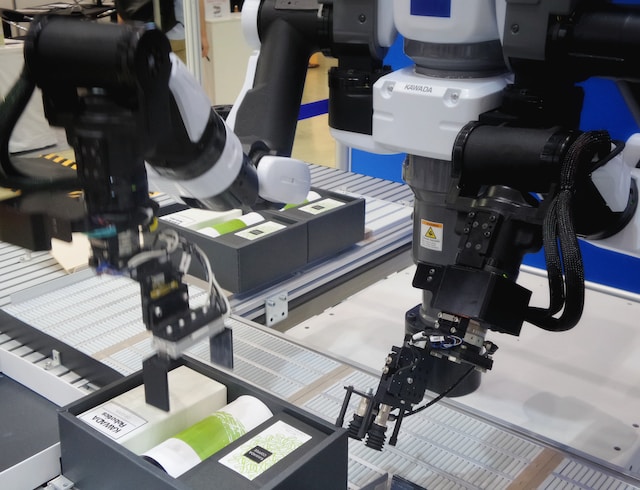In this article, we will be sharing a comprehensive overview of the latest trends in digital transformation in 2023. We want to familiarize you with all the transformative technologies, strategies, and practices that are shaping the digital landscape.
The article will explore key areas such as artificial intelligence, cloud computing, data analytics, Internet of Things (IoT), and automation. It will discuss the impact of these trends on businesses, industries, and society as a whole, highlighting the opportunities and challenges they present.
Trend 1: Artificial Intelligence (AI)

Applications in Digital Transformation
AI has a lot of potential to be applied in digital transformation. Offering data analysis and insights, streamlining procedures, and improving customer experience are all different ways in which AI can be used. Analytics tools powered by AI can mine useful information from data, enabling data-driven decision-making.
AI automation improves productivity by streamlining processes. AI also improves cybersecurity by quickly identifying and countering threats. Artificial intelligence-powered chatbots and virtual assistants enhance customer interactions and provide individualized support.
Overall, AI is a key factor in the digital transformation process because it helps businesses make wise decisions, automate processes, and provide top-notch customer service.
Examples of Successful AI Implementations
There have been multiple instances where AI has been successfully used for digital transformation in different industries. For instance, in the healthcare industry, AI has been used to enhance diagnostics by analyzing medical images and more accurately identifying abnormalities. By making personalized product recommendations based on user preferences and browsing history, AI-powered recommendation systems have improved customer experiences in the retail sector.
Additionally, AI has transformed supply chain management by automating logistics procedures, forecasting demand patterns, and optimizing inventory levels. AI algorithms are used in the financial sector for algorithmic trading, risk analysis, and fraud detection. These examples show how AI tools have made it possible for businesses to transform their operations, improve decision-making, and provide customers with better value.
Benefits and Challenges of Adopting AI in Digital Transformation
There are a lot of benefits as well as challenges when it comes to adapting AI to digital transformation. The first benefit of AI is that it increases productivity and efficiency by automating routine tasks and freeing up human resources for more strategic projects. By analyzing vast amounts of data and drawing out insightful conclusions, it also enables organizations to make data-driven decisions.
AI also enhances the customer experience by enabling personalized emails as a way of communicating and effective support infrastructure. Experience the ease of creating a customized and polished signature with our email signature generator. Give it a try and elevate your digital presence! Adopting AI, however, comes with difficulties. It can be challenging and expensive to invest in talent and infrastructure to integrate AI into current systems and processes. When utilizing AI algorithms, ensuring data quality and privacy becomes essential. To increase trust in AI systems, ethical issues like bias reduction and transparency must be addressed. For the adoption and implementation of AI in digital transformation to be successful, it is crucial to strike a balance between the advantages and these difficulties.
Trend 2: Cloud Computing

Exploring the Role of Cloud Computing in Digital Transformation
Cloud computing has played a major role when it comes to digital transformation.
It enables businesses to scale their computing, storage, and infrastructure resources in accordance with their requirements, obviating the need for pricey on-premises infrastructure. Businesses can quickly deploy and scale applications thanks to the agility and flexibility offered by cloud platforms.
Additionally, cloud computing supports remote work and collaboration by enabling safe access to data and applications from any location. The availability of a wide range of cloud-based services, such as AI, analytics, and IoT, that allow organizations to use cutting-edge technologies for their journey toward digital transformation also speeds up innovation.
Advantages of Cloud-Based Solutions for Businesses
Cloud-based solutions offer significant advantages for businesses in their digital transformation efforts. First, they offer scalability, enabling businesses to quickly increase or decrease resources in response to demand while avoiding up-front infrastructure costs. The key is to find proper cloud solutions by using cloud discounts for SaaS and fitting them into your budget to save more resources. Second, cloud solutions provide flexibility by allowing remote access to data and applications from any location, promoting remote work and collaboration.
Cloud platforms also guarantee little downtime and continuous operations thanks to their high availability and dependability. Additionally, cloud-based solutions provide cutting-edge security features like data encryption and routine backups to protect sensitive data. Cloud-based solutions are a desirable option for businesses looking for flexibility, cost-effectiveness, and increased productivity as they embark on their digital transformation journey because of these benefits.
Considerations for Migrating to the Cloud in the Digital Transformation Journey
Migrating to the cloud in the digital transformation journey requires careful consideration.
Organizations must first evaluate their current infrastructure and applications to determine whether a migration is feasible and compatible. To ensure data protection and regulatory adherence, a thorough assessment of security and compliance requirements is also essential. Analysis of the cost implications, including pricing strategies and ongoing operational costs, is necessary.
Additionally, a clear migration strategy should be in place to minimize disruption. This strategy should include data transfer, training, and change management. Successful migration to the cloud depends on choosing the best cloud service provider with a proven track record and top-notch customer service.
Trend 3: Data Analytics and Big Data

Understanding the Power of Data in Driving Digital Transformation
Data plays a central role in driving digital transformation initiatives. Organizations can use data to their advantage to gain insightful information and come to wise decisions. Businesses can tailor their strategies and offerings by identifying patterns, trends, and customer preferences through the collection, analysis, and interpretation of data.
Agility, efficiency, and innovation are enabled by data-driven decision-making. Data also supports the creation and application of cutting-edge technologies like AI and machine learning. Businesses that use data wisely can gain a competitive advantage, improve customer experiences, streamline operations, and bring about seismic shifts in the digital environment.
Leveraging Data Analytics for Actionable Insights and Decision-Making
Leveraging data analytics in the digital transformation journey empowers organizations to derive actionable insights and make informed decisions. Businesses can analyze enormous amounts of data using data analytics to spot trends and glean insightful information.
Organizations can find trends, predict future results, and improve processes by implementing advanced analytics techniques like predictive modeling and machine learning algorithms. The proactive decisions, resource allocation, and targeted strategies made possible by these actionable insights boost efficiency, improve customer experiences, and give businesses a competitive edge in the rapidly changing digital environment.
Addressing Data Privacy and Security Concerns in the Era of Digital Transformation
Leveraging data analytics in the digital transformation journey empowers organizations to derive actionable insights and make informed decisions. Using data analytics, businesses can examine enormous amounts of data to identify trends and discover useful information.
Organizations can use advanced analytics techniques like predictive modeling and machine learning algorithms to identify trends, forecast future outcomes, and enhance processes. These actionable insights increase efficiency, enhance customer experiences, and give businesses a competitive edge in the rapidly evolving digital environment through proactive decisions, resource allocation, and targeted strategies.
Trend 4: Internet of Things (IoT)

Exploring the Potential of Iot in Transforming Industries
The Internet of Things (IoT) has the potential to revolutionize industries through its ability to connect devices and enable seamless data exchange. IoT makes real-time monitoring, proactive maintenance, and improved production techniques possible in manufacturing. IoT in healthcare enables remote patient monitoring, individualized care, and better clinical outcomes.
IoT helps the retail sector by facilitating supply chain optimization, personalized shopping experiences, and inventory tracking. Additionally, IoT improves initiatives for smart cities, efficient transportation, and energy management. IoT is poised to reshape industries, boost operational effectiveness, and open up new possibilities for innovation and growth thanks to its transformative capabilities.
Examples of Iot Applications in Digital Transformation
IoT applications in digital transformation are widespread across industries. IoT sensors built into machines in the manufacturing industry allow for automated quality control, predictive maintenance, and real-time monitoring. IoT devices in the healthcare industry monitor patient vitals remotely, streamline hospital operations, and track patient vitals.
Retailers use IoT for customer-specific experiences, smart shelves, and inventory management. IoT makes fleet management, logistics improvement, and vehicle connectivity possible in the transportation sector. Smart cities use IoT for intelligent infrastructure, waste management, and energy management. These examples show how IoT applications drive digital transformation by boosting productivity, facilitating better decisions, and opening up creative solutions across various industries.
Challenges and Considerations for Implementing Iot in Digital Transformation Initiatives
Implementing IoT in digital transformation initiatives comes with its challenges and considerations. First and foremost, ensuring data security and privacy is essential due to the vast number of connected devices and potential vulnerabilities. To prevent fragmentation, interoperability and compatibility issues must be resolved between various IoT systems and devices.
To support the increasing volume of data generated by connected devices, scalability and infrastructure readiness must be considered. Organizations must also evaluate the financial effects of device acquisition, connectivity, and upkeep. To maintain trust and transparency in IoT implementations, addressing ethical issues and regulatory compliance is crucial.
Trend 5: Automation and Robotics

The Role of Automation in Streamlining Processes and Improving Efficiency
Automation plays a vital role in digital transformation by streamlining processes and improving efficiency. Organizations can decrease errors, save time, and redirect resources to more value-added activities by automating repetitive and manual tasks. Organizations can also optimize workflows, boost productivity, and guarantee consistent execution by using robotic process automation (RPA) and intelligent automation technologies.
Additionally, automation helps businesses react quickly to customer and market demands, increasing their overall agility and speeding up decision-making. In the process of going through a digital transformation, businesses can increase operational effectiveness, save money, and improve customer satisfaction by utilizing automation.
Impact of Robotics on Job Roles and Workforce Dynamics
The impact of robotics on job roles and workforce dynamics is a significant aspect of digital transformation. Robotics and automation can replace some manual and repetitive tasks, but they also change job roles and open up new opportunities. The dynamics of the workforce are shifting toward retraining and upgrading workers to use new technologies and collaborate with robots.
Humans must concentrate on complex problem-solving, creativity, and critical thinking while working in collaboration with robots. To maximize productivity, job satisfaction, and sustainable growth in the digital era, organizations must proactively manage this transition, ensuring a balance between automation and workforce development.
Ethical Considerations and Human-Machine Collaboration in the Age of Automation
Ethical considerations and human-machine collaboration are crucial in the age of automation. Organizations must address concerns about job displacement, ensuring that affected workers have the opportunity to reskill and find new employment. In order to reduce biases and stop discrimination, fairness, transparency, and accountability become crucial when designing and implementing automated systems.
The goal of human-machine collaboration is to foster a symbiotic relationship by utilizing the distinctive abilities of both species. It entails creating workflows that blend the productivity and accuracy of machines with the creativity, empathy, and critical thinking of people. Organizations can fully utilize automation while putting a priority on human welfare and societal benefits by encouraging ethical practices and human-machine collaboration.
Implications and Opportunities
Broader Impact of Digital Transformation Trends on Businesses and Society
Digital transformation trends have a profound impact on businesses and society. They encourage innovation, boost output, and make new business models possible. Businesses can provide individualized experiences, streamline processes, and open new revenue streams.
However, the societal effects also include the digital divide, changes in the workforce, and privacy issues. Additionally, digital transformation offers chances for sustainable growth, better service access, and improved connectivity. Utilizing digital transformation to have a positive and inclusive impact on businesses and society as a whole requires striking a balance between the advantages and the difficulties.
Identifying Opportunities for Innovation and Growth Through Digital Transformation
Digital transformation presents organizations with vast opportunities for innovation and growth. Businesses can improve customer experiences, streamline operations, and create new goods or services by embracing emerging technologies.
Organizations can make data-driven decisions, boost efficiency, and promote continuous improvement by utilizing automation, artificial intelligence, and data analytics. Digital transformation also creates opportunities for collaboration, agility, and scalability, enabling businesses to stay one step ahead of the competition and open up new revenue streams and market expansion.
Risks and Challenges Associated With Digital Transformation Initiatives
Digital transformation initiatives come with inherent risks and challenges. Privacy issues and data security breaches are significant risks that businesses must deal with. Integration of legacy systems, hiring talent, and skill upgrading present difficulties. Transformation efforts may be hampered by organizational culture and resistance to change. Additional difficulties include managing implementation and maintenance costs as well as ensuring regulatory compliance. Effective risk management, stakeholder engagement, and strategic planning are crucial to overcome these obstacles and guarantee positive outcomes from digital transformation.
Conclusion – Final Thoughts on Embracing Digital Transformation for Long-Term Success
Digital transformation is a dynamic and ever-evolving process that continues to shape the business landscape in 2023. The trends covered in this article, such as automation, cloud computing, IoT, and AI, offer enormous opportunities for businesses to foster innovation, boost productivity, and provide exceptional customer experiences. Navigating the associated difficulties, such as data security, workforce transformation, and ethical issues, is crucial. Businesses can maintain their competitiveness, thrive in the digital age, and pave the way for a successful future of digital transformation by embracing these trends and addressing the risks.

Author Bio
Radina Skorcheva is a Digital Marketing Specialist at Inbound Blogging, specializing in Content marketing and SEO. Radina is helping brands share their voices and scale their businesses through powerful digital marketing strategies. You can connect with her on LinkedIn.

